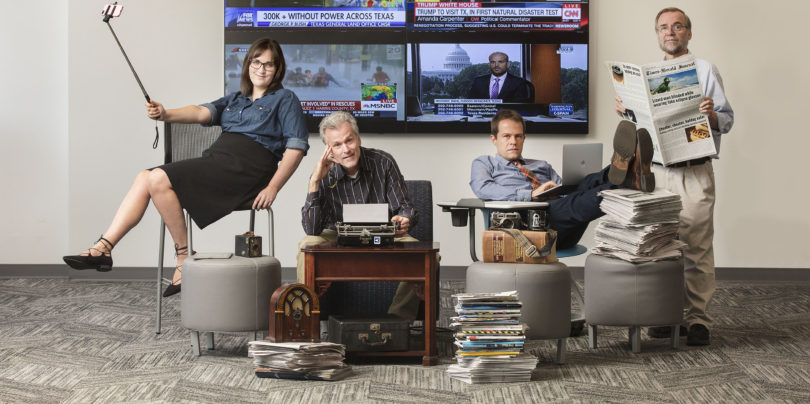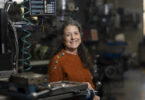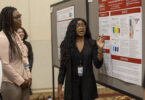By Allyson Mann, Office of Research
Photography by Terry Allen
A year ago, a contentious election culminated in a new president for the United States. It also introduced the country — and the world — to fake news.
From individual stories like Pizzagate (an online story alleging that a Washington, D.C., pizzeria was involved in a child sex ring led by Hillary Clinton) to examinations of its role in the presidential election, fake news has become a staple of headlines. Recent stories have explored how fake news is created, how it goes viral, and increasingly, how to combat it.
But the concept of fake news is not new. For perspective, Research Magazine turned to four experts at the Grady College of Journalism and Mass Communication — faculty members Jay Hamilton, Bart Wojdynski and Barry Hollander and Ph.D. student Jessica Maddox. They approach the topic from different angles, but share at least one premise: Fake news means different things to different people.
The definition of fake news has expanded, the researchers said, from its original meaning-a story that’s deliberately made up for personal, political or economic gain. Fake news also may refer to a story that was true in its original form but was altered, accidentally or deliberately, through the process of being shared, usually through social networks. And it’s used as a pejorative term, applied by the user to discredit something he or she doesn’t agree with.
“Fake news is multiple things, and that’s what makes it so complicated,” said Jay Hamilton, cultural historian of communication and Jim Kennedy Professor of New Media.
Today’s concerns about fake news are informed by our nation’s experiences with news bias and propaganda, he said.
During the late 19th-century circulation battles, publishers like William Randolph Hearst sensationally slanted news (or invented it, as in the case of the sinking of the Maine in 1898) to increase newspaper readership and promote a particular political position. In the latter half of the 1930s, Father Charles Coughlin used his weekly national radio program to drum up anti-Semitic sentiment and consolidate a nationalist political program sympathetic to fascist governments.
Prevalent in these concerns, Hamilton said, is the idea that messages are powerful and people are susceptible. But there’s a big difference between news bias and fake news, according to Hamilton, head of the department of entertainment and media studies.
“One’s about standpoint and skew. That’s bias,” he said. Fake news “is about fabrication and completely nonsensical things that have never happened.”
And what’s driving the fake news phenomenon now is a hyper-competitive online media marketplace seeking to capitalize on internet users’ attention to bring in advertising dollars.
To address the problem, Hamilton recommends reforming the structure of online advertising sales and giving users tools to investigate content. He’s impressed with stopfake.org, a journalism project out of Ukraine that verifies facts and refutes false reports about events in Crimea covered in the media.
“It’s really instructive that such an innovative effort at combating fake news came out of a former Soviet republic,” he said. “Who else is going to be so skilled at wading through the crap than people who have had to deal with that for generations?”
Bart Wojdynski, assistant professor of journalism, wants to know how visual cues influence people when they’re evaluating information, particularly since readers increasingly view online information outside of its original context.
“A majority of people under 45 access news daily via social media channels like Facebook and Twitter, where it’s interspersed with content from their friends, acquaintances and colleagues,” he said.
In this “news snacking” context, Wojdynski said, people are less likely to question the information or the source.
“We know that people consume news for different reasons, and sometimes there’s a diversion component,” he said. “If you’re trying to pass the time for two minutes while waiting in line, you’re probably not going to do a lot of in-depth research to verify the sources of a story-especially on a mobile device.”
It’s not just social media that’s blurred the lines between news, entertainment and advertising, according to Wojdynski, who serves as director of the Digital Media Attention and Cognition Lab.
“It makes sense that consumers don’t always think of investigative reporting when they think of news, because news organizations are involved in a whole lot more, like car sections and living guides,” he said. “That has diluted the perceived value of news.”
Wojdynski is exploring how people’s scrutiny of the news is driven by confirmation bias (information that confirms what they think) and desirability bias (information that they want to be true).
“Ultimately, I think that’s what it boils down to-the degree to which people question what they see and read,” he said.
Barry Hollander’s research involves people who question everything.
“I look at conspiracy theories-why people believe them, and what factors make them more likely to believe,” said Hollander, professor of journalism.
In a recent study, Hollander looked at theories of the left and right, who believes them and why. Some people, he found, believe in all conspiracy theories, regardless of which side they’re on, because they think the world is out to get them.
“It’s easy to make fun of people who believe in these crazy stories, but it tells us something about the way they make sense of the political world,” he said.
Hollander believes that readers adjust their standards of credibility based on their opinions.
“People hear what they want to hear. They believe what they want to believe,” he said. “That’s why fake news succeeds.”
“If you really hate Donald Trump, or if you really hate Hillary Clinton, you are much more likely to believe fake news that makes that person look bad.”
Trying to counter a fake news story is difficult when people believe the media is biased against their viewpoint. And even when readers don’t subscribe to conspiracy theories, they still have a tendency to gravitate toward people who share similar views. While that clustering used to happen in geographic spaces — people who shared the same socioeconomic status and political views congregated in the same neighborhoods, for example — it now plays out in social media spaces.
“We all create these bubbles, but the lines of demarcation are much brighter now because of the fragmentation of the media,” he said. “We can now watch the cable news outlet that agrees with our point of view. We can have Facebook friends and follow people on Twitter who agree with our point of view.”
The rise of filter bubbles, which allow people to self-select who and what they’re exposed to, is part of the fake news problem, according to Jessica Maddox.
“If you normally watch CNN, flip to Fox News for a couple of minutes,” said Maddox, who expects to earn her Ph.D. next year. “It’s good to step outside of your comfort zone when it comes to media.”
Maddox has explored memes — pieces of media that spread from person to person via the internet and are tweaked along the way. The concept is similar to the kids’ game of telephone, where the message heard by the last person bears virtually no resemblance to what was originally said.
“It’s almost done rather harmlessly,” she said. “You’re just moving this information along, but without stopping to check or evaluate, it can become something completely different in the end.”
At the root of the issue is not just media literacy, she said, but social media literacy.
“So many of us — millennials through baby boomers — never received any kind of social media training,” she said. “We were just thrown into it, and we all learned as we went.”
It’s not a partisan issue, according to Maddox. Everyone is susceptible to believing, and passing along, fake news. She once posted a fake news story on Facebook-about Supreme Court Justice Neil Gorsuch, then a nominee, starting a fascism club in college-and later learned it wasn’t true.
“That was a really humbling moment,” she said.
What we need now, Maddox said, is to apply critical thinking skills to social media. Before social media, it was easy to identify fake news-it was on the cover of the tabloid newspaper in the checkout line at the supermarket. These days, it’s not so easy.
“We need to realize that article about Cher’s alien baby can be on our social media feeds now,” she said. “We as responsible citizens should pause when we see something like that.”
No matter the medium — newspaper, broadcast news, Facebook — Maddox has the same advice: “Question the source — that’s what I always advise people to do.”
This story originally appeared in the Fall 2017 issue of Research magazine.






